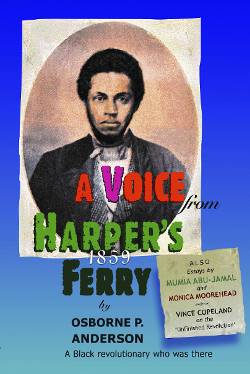A Voice From Harpers Ferry
Osborne P. Anderson’s account of the raid on Harper‘s Ferry appeared in pamphlet form in 1861 right after the start of the Civil War. However. it was not set in print again until 1974. That year Vince Copeland, whose introduction “The Unfinished Revolution” is included in this book, rescued it from oblivion. Also includes contributions from Mumia Abu-Jamal and Monica Moorehead.
The unfinished revolution By Vince Copeland
Much has been written about the Harper’s Ferry raid. But Osborne P. Anderson’s story — in the words of W.E.B. Du Bois “the most interesting and reliable account of the raid” — has a special significance that has been too long neglected.
First, Anderson was one of the actual participants, and being Black, he might be expected to have a somewhat different view of the affair than even the most inspired white supporter of John Brown. Second, he apparently wrote the pamphlet with the hope of encouraging a general slave insurrection. And third, he obviously expected other whites to imitate the action of John Brown and help supply the arms for the insurrection, as well as take up arms themselves.
READ MOREHe was interested, like most other Black and white abolitionists of that very revolutionary period, in continuing the revolution that John Brown’s band had begun. But he seems to have based his optimism upon the possibilities of slave insurrection, rather more than upon white support, which he must have thought of as an important auxiliary force rather than as the main body of struggle.
He took pains to emphasize the number of slaves who accepted guns the moment guns were offered to them. He pointed out what few subsequent narrators of the event have: namely that of the seventeen revolutionaries who died at Harper’: Ferry (before the legal lynching of Brown and the others after the trial), nine were Black.
Eight whites and two Blacks of the original band were killed in the conflict in addition to the hastily armed seven Black slaves. Two other Blacks were executed with Brown.
History has finally given Brown tremendous credit for what was indeed a tremendous feat. But Brown had been planning it for decades and the others in the band had been thinking for months and for years about how to strike this dramatic blow. What about the seven nameless Black people who died for Black freedom with no prior notice whatever?
They, too, no doubt, had thought for years about freedom — their own freedom. They had lacked all possibility, all weapons, all communication for struggle. But confronted with an opportunity given them by strangers, most of whom were of the same race as the hated master class, they gave their lives in a moment and apparently without a qualm.
History, even revolutionary history, treats them as fillers — in of blank spaces. Did they simply take the guns and shoot and get shot like so many extras in the movies?
Anderson did not think so.
Although he does not expand upon the facts when he refers to the number of “colored” men killed, his emphasis upon the number is obviously not due just to his racial pride. It must always be borne in mind that he was speaking to a generation to which this incident would conjure up an extremely earth-shaking perspective. And even the slightest emphasis would go a long way.
COLLAPSE


